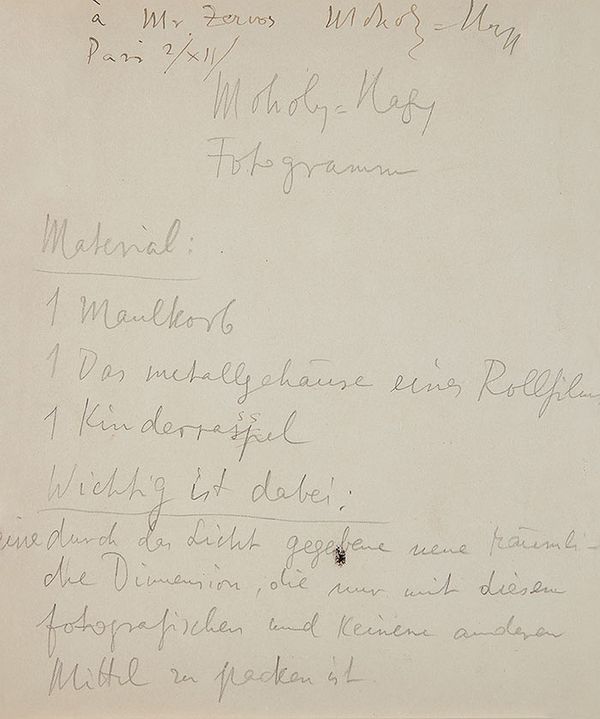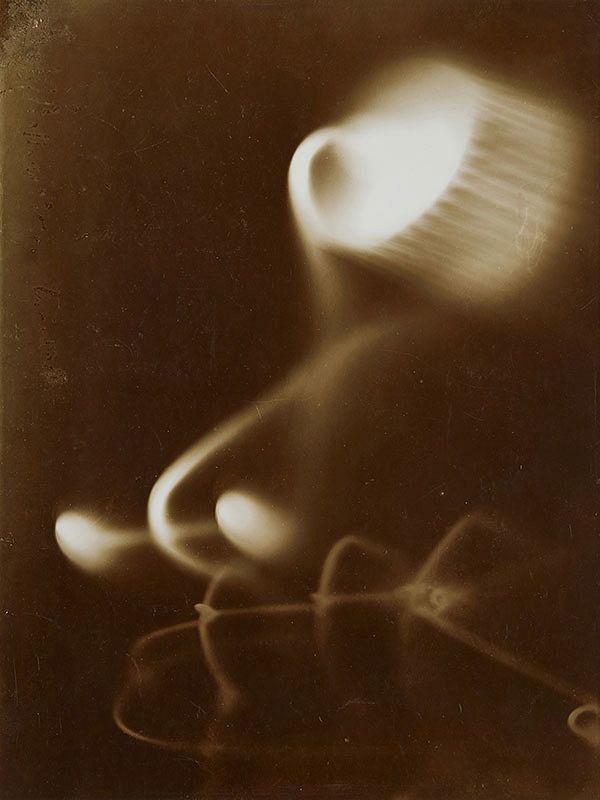László Moholy-Nagy, Photogram, 1920s. Photographs New York.
In the 1920s, the visionary Bauhaus artist László Moholy-Nagy began making a dynamic series of photographic images without the use of a camera. By placing objects on or over a sheet of photographic paper and carefully directing its exposure to light, Moholy-Nagy created a unique image known as a photogram. On offer in Phillips’ October 7th Photographs sale is a seminal example from this period, one that shows how this simple technique could, in Moholy-Nagy’s hands, yield transcendent results.
The photogram, or camera-less record of forms produced by light, which embodies the unique nature of the photographic process, is the real key to photography.
– László Moholy-Nagy
The photogram technique is tied to photography’s earliest history. William Henry Fox Talbot, inventor of the first negative/positive photographic process, made camera-less images in the 1800s, as did Anna Atkins. Moholy-Nagy updated the process for the modern era, working with the more sophisticated photographic materials of his day, employing a greater array of objects (which he sometimes moved during the exposure), and experimenting with the direction and intensity of the light source. Straightforward delineation fell by the wayside as Moholy-Nagy expanded the expressive potential of the technique.

László Moholy-Nagy, Photogram (verso), 1920s. Photographs New York.
This photogram is distinguished by Moholy-Nagy’s detailed notations on the reverse. It is rare to see such extensive writing in Moholy-Nagy’s hand on his photographs, and here he sets forth a concise treatise on his work with the photogram process, beginning with an inventory of the three objects used in making this image under the heading Material:
1 muzzle
1 metal housing [spool] of a roll film
1 child’s rattle
In Moholy-Nagy’s handling these quotidian objects are transformed into pure compositional elements within a dynamic and animated whole. In further notations on the verso of this print, Moholy-Nagy addresses the transformative power of the photogram process, as well as its unique ability to create an entirely new category of imagery. He writes:
What is important here:
A new spatial dimension given by light that can be captured with this photographic means and no other means.
Moholy-Nagy’s belief in the photogram as a tool for artistic expression was fundamental to his artistic practice. "The photogram, or camera-less record of forms produced by light, which embodies the unique nature of the photographic process, is the real key to photography," he wrote in his 1933 essay A New Instrument of Vision. The photogram became a core concept for his ever-evolving curriculum of photography that he carried from the Bauhaus in Germany to the New Bauhaus and the Institute of Design in Chicago.

László Moholy-Nagy, Self Portrait, 1925. Sold for $112,500. The Odyssey of Collecting: Photographs from Joy of Giving Something Foundation, New York.
Moholy-Nagy made photograms throughout his career, and these are closely linked with his work in other media. In the abstract paintings of the 1920s and 1930s, Moholy-Nagy’s rendering of varying degrees of translucency is inherited directly from his experimentation with light in his photograms. His plastic sculptures of the 1940s show yet another way in which Moholy-Nagy used light as an artistic medium. Newly discovered in 2010, this photogram takes its place within Moholy-Nagy’s multi-disciplinary body of work, an oeuvre that shows a remarkable persistence of vision across all media.
Moholy-Nagy’s photograms were revelatory in their day and continue to influence the work of such artists as Adam Fuss, Susan Derges, Garry Fabian Miller, Walead Beshty, Christopher Bucklow, and many others who carry on his legacy of rigorous experimentation with light.
Discover More from Photographs >
Recommended Reading
Promethean Figures: Peter Beard and Francis Bacon, 1976 >
A Mapping of the Self: Photographs from the Collection of Peter McLeavey >
